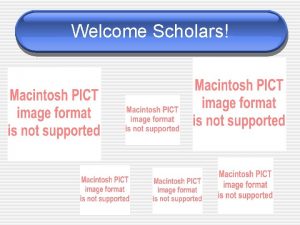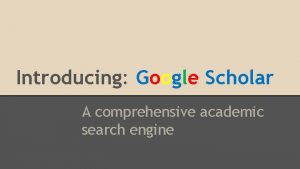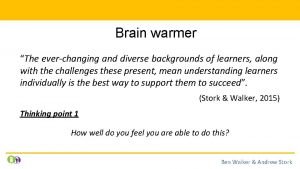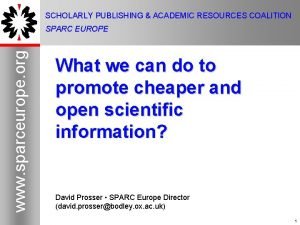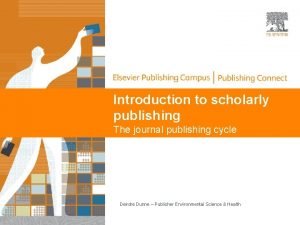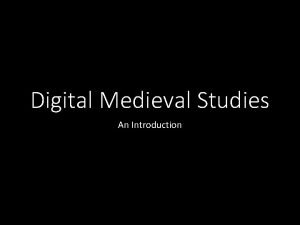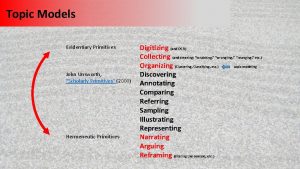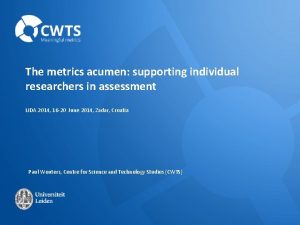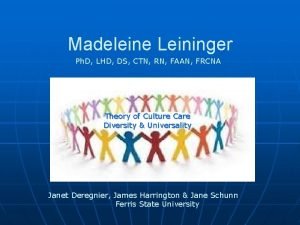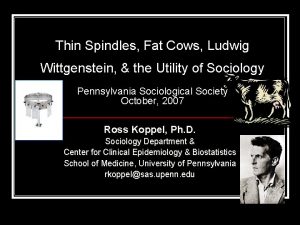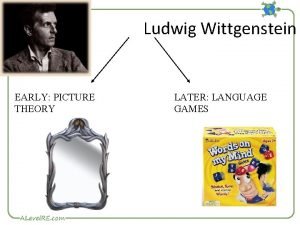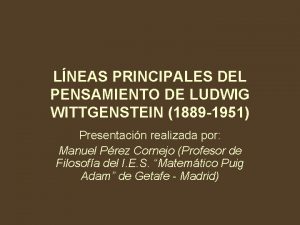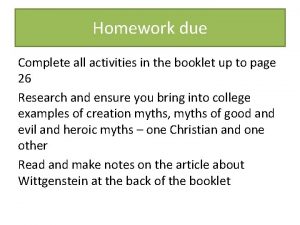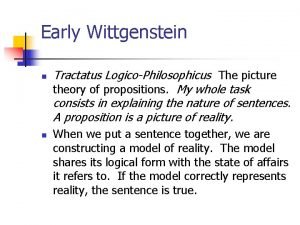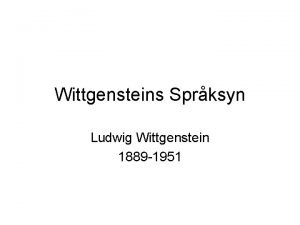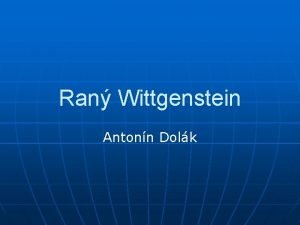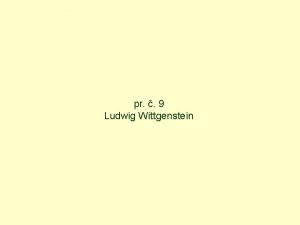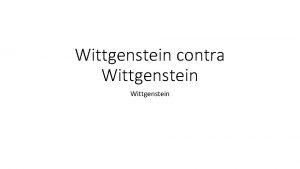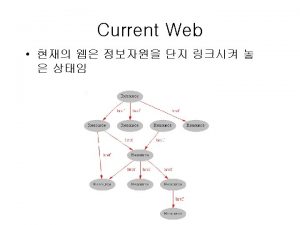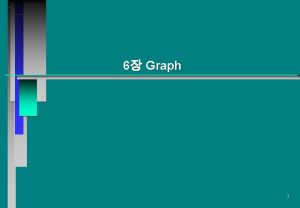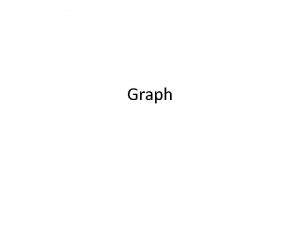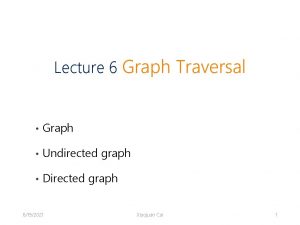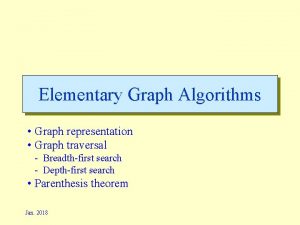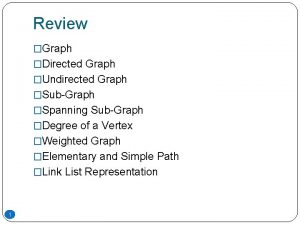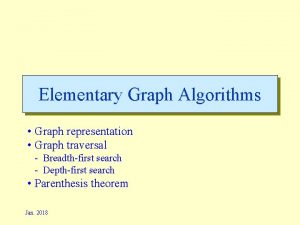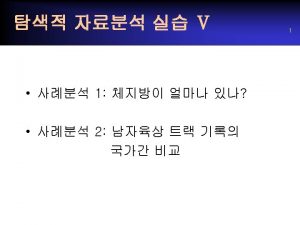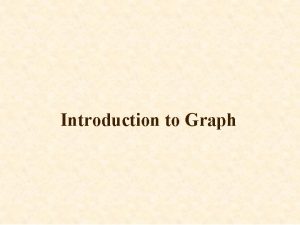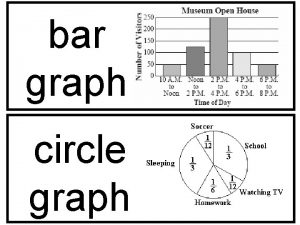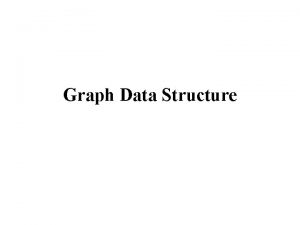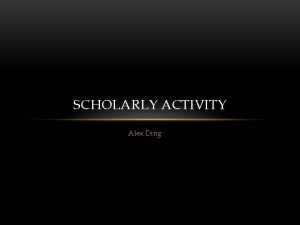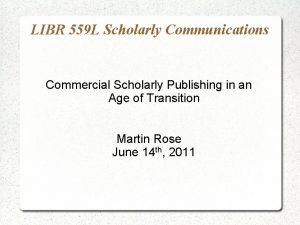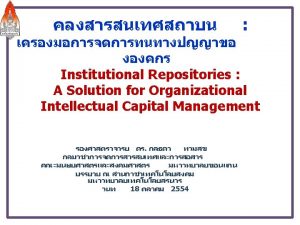Towards a Social Semantic Scholarly Graph the Wittgenstein















































- Slides: 47

Towards a Social Semantic Scholarly Graph: the ‘Wittgenstein Incubator’ as part of an attempt to further model scholarly discoursive interaction in DM 2 E Prof. Dr. Stefan Gradmann (KU Leuven) Easy Tools for Difficult Texts, Den Haag, Huygens Institute, 19/04/2013 co-funded by the European Union

Overview Will cover: • An Introduction to DM 2 E • The Scholarly Domain Model • The Wittgenstein Incubator Will not cover: • Intro to RDF/S • Intro to Europeana and the EDM Towards a Social Semantic Scholarly Graph Stefan Gradmann, Huygens Instituut, 19/04/2013 2

02/2012 -01/2015 Co-funded by the EC Towards a Social Semantic Scholarly Graph Stefan Gradmann, Huygens Instituut, 19/04/2013 3

Digitised Manuscripts to Europeana (DM 2 E): Who (1)? • Content Providers – European Association for Jewish Culture (Judaica) – Max-Planck-Institut für Wissenschaftsgeschichte (ECHO) – Österreichische Nationalbibliothek (Google) – Staatsbibliothek zu Berlin (Kalliope) – University of Bergen (Wittgenstein) – CNRS ITEM (Nietzsche) – National Library of Israel (Judaica) – Berlin Brandenburgische Akademie (German Text Archive) – Humboldt-Universität zu Berlin (Polytechnisches Journal) • Technology Providers – Ex. Libris (Aleph, MARC sources management) – Universität Mannheim / Freie Universität Berlin (Lo. D 2, D 2 R, SILK) – Max-Planck-Institut für Wissenschaftsgeschichte (ECHO) – Net 7 S. r. l. (Muruca/Pundit) – National Technical University of Athens (MINT) Towards a Social Semantic Scholarly Graph Stefan Gradmann, Huygens Instituut, 19/04/2013 4

Digitised Manuscripts to Europeana (DM 2 E): Who (2)? • Digital Humanities Community – Dr. Tobias Blanke (King's College, London) – Sally Chambers (The European Library / DARIAH-D) – Prof. Dr. Stefan Gradmann (KU Leuven, Chair) – Prof. Dr. Gerhard Lauer (Göttingen University) – Dr. Alois Pichler (UIB) – Dr. Jürgen Renn (MPIWG) – Dr. Laurent Romary (HUB) – Prof. Dr. Susan Schreibman (Trinity College Dublin) – Dr. Claire Warwick (University College, London) • Community Building – Open Knowledge Foundation (OKFN) • Coordination, Management & Information Science – Humboldt-Universität zu Berlin (HUB) • TEL / Europeana Foundation (Europeana Research) Towards a Social Semantic Scholarly Graph Stefan Gradmann, Huygens Instituut, 19/04/2013 5

Digitised Manuscripts to Europeana (DM 2 E): Who (3)? • New Associated Partners Universitätsbibliothek Frankfurt a. M. (UBFFM) Bulgarian Academie of Sciences (BAS) Ontotext Brandeis University Georg Eckert Institute for International Textbook Research (GEI) – Joint Distribution Committee (JDC) – – – Towards a Social Semantic Scholarly Graph Stefan Gradmann, Huygens Instituut, 19/04/2013 6

Digitised Manuscripts to Europeana (DM 2 E): What? • Provide substantial amounts of digital content to Europeana with a focus on digitised manuscripts (WP 1) • Integrate existing technical building blocks – from Europeana development – as well as from generic Lo. D oriented development – into a generic production chain for migrating data from various sources to the EDM as well – as for the contextualisation of the object representations (WP 2). • Explore usage scenarios of EDM metadata together with object data in a specialised RDF graph based platform for humanities research making available specialised visualisation and reasoning environments (WP 3). Towards a Social Semantic Scholarly Graph Stefan Gradmann, Huygens Instituut, 19/04/2013 7

WP 3: Digital Humanities Requirements and Related Engineering - Context Goal: lower the barriers for digital content curation by providing an integrated, flexible, semantic based environment targeted to digital humanities scholars Towards a Social Semantic Scholarly Graph Stefan Gradmann, Huygens Instituut, 19/04/2013 8

Expected WP 3 Results • Prototype platform enabling digital scholarship in combining EDM RDF metadata, digital surrogates and Linked Data. . . • … building on an ontological representation of scholarly work based on a common understanding of its constituents • . . . resulting in a increasingly complex social semantic scholarly graph containing RDF statements such as – Version. A – is. Successor. Of – Version. B – Statement 1 – contradicts - Statement 2 – Scribe. Y – copied. From – Scribe. Z • … and which could feed back richly contextualised EDM to Europeana! Towards a Social Semantic Scholarly Graph Stefan Gradmann, Huygens Instituut, 19/04/2013 9

An example: De arte venandi cum avibus Towards a Social Semantic Scholarly Graph Stefan Gradmann, Huygens Instituut, 19/04/2013 10

De Arte Venandi … (1) Towards a Social Semantic Scholarly Graph Stefan Gradmann, Huygens Instituut, 19/04/2013 11

De Arte Venandi … (2) Towards a Social Semantic Scholarly Graph Stefan Gradmann, Huygens Instituut, 19/04/2013 12

De Arte Venandi … (3) Towards a Social Semantic Scholarly Graph Stefan Gradmann, Huygens Instituut, 19/04/2013 13

De Arte Venandi … Subgraph 1 Towards a Social Semantic Scholarly Graph Stefan Gradmann, Huygens Instituut, 19/04/2013 14

De Arte Venandi … (4) Towards a Social Semantic Scholarly Graph Stefan Gradmann, Huygens Instituut, 19/04/2013 15

De Arte Venandi … (5) Towards a Social Semantic Scholarly Graph Stefan Gradmann, Huygens Instituut, 19/04/2013 16

De Arte Venandi … Subgraphs 1+2 Towards a Social Semantic Scholarly Graph Stefan Gradmann, Huygens Instituut, 19/04/2013 17

De Arte Venandi … (6) Towards a Social Semantic Scholarly Graph Stefan Gradmann, Huygens Instituut, 19/04/2013 18

De Arte Venandi … (6) Towards a Social Semantic Scholarly Graph Stefan Gradmann, Huygens Instituut, 19/04/2013 19

De Arte Venandi … (6) Towards a Social Semantic Scholarly Graph Stefan Gradmann, Huygens Instituut, 19/04/2013 20

De Arte Venandi … done 'right' Towards a Social Semantic Scholarly Graph Stefan Gradmann, Huygens Instituut, 19/04/2013 21

De Arte Venandi … there's more! Towards a Social Semantic Scholarly Graph Stefan Gradmann, Huygens Instituut, 19/04/2013 22

De Arte Venandi … there's more (2)! Towards a Social Semantic Scholarly Graph Stefan Gradmann, Huygens Instituut, 19/04/2013 23

De Arte Venandi … there's more (3)! Towards a Social Semantic Scholarly Graph Stefan Gradmann, Huygens Instituut, 19/04/2013 24

Beyond Infrastructure: The Scholarly Domain Model Towards a Social Semantic Scholarly Graph Stefan Gradmann, Huygens Instituut, 19/04/2013 25

Cyberinfrastructure: Atkins Report (2003) • “Mother of all infrastructure layer cakes” impacted – “Our Cultural Commonwealth”, e-Science (UK), Text. Grid, DARIAH – With Isidore, Europeana and others being more content oriented and Lo. D based Towards a Social Semantic Scholarly Graph Stefan Gradmann, Huygens Instituut, 19/04/2013 26

Why Beyond Infrastructure? • We want to move beyond emulation mode … • … beyond 'pages' and 'links' • “Research infrastructure is not research just as roads are not economic activity. We tend to forget when confronted by large infrastructure projects that they are not an end in themselves. [. . . ] Infrastructure projects can become ends in themselves by developing into an industry that promotes continued investment. To sustain infrastructure there develops a class of people whose jobs are tied to infrastructure investment. ” Rockwell (2010) • → how can we better understand model primary research activities in order to re-implement them more thoroughly? Towards a Social Semantic Scholarly Graph Stefan Gradmann, Huygens Instituut, 19/04/2013 27

Scholarly Primitives and Dynamics • Unsworth (2000) – discovering, annotating, comparing, referring, sampling, illustrating, representing – as the basis for tool-building enterprises for the Digital Humanities • Palmer et al. (2009)(“scholarly information activities”) – searching, collecting, reading, writing, collaborating • … Blanke & Hedges (2011), Bamboo (2010), Mc. Carty et. al. (2002) Anderson et al. (2010). . . • Bernardou et al. (2010) – CRM activity and event based process model connecting research activities with information objects and propositions, i. e. including argumentation structures Towards a Social Semantic Scholarly Graph Stefan Gradmann, Huygens Instituut, 19/04/2013 28

The Glue: RDF / RDFS • Typed statements on web resources (triples) and how they relate to each other, e. g. • + RDF Schema (RDFS) language with constructors for suband superclasses and -properties including the concept of inheritance • → simple, deterministic logical operations on triple aggregations (“reasoning”) Towards a Social Semantic Scholarly Graph Stefan Gradmann, Huygens Instituut, 19/04/2013 29

The Scholarly Domain. . . … from 10. 000 feet above Towards a Social Semantic Scholarly Graph Stefan Gradmann, Huygens Instituut, 19/04/2013 30

Input Area Details Towards a Social Semantic Scholarly Graph Stefan Gradmann, Huygens Instituut, 19/04/2013 31

+ Output Towards a Social Semantic Scholarly Graph Stefan Gradmann, Huygens Instituut, 19/04/2013 32

+ Metadata Towards a Social Semantic Scholarly Graph Stefan Gradmann, Huygens Instituut, 19/04/2013 33

+ Social Context Towards a Social Semantic Scholarly Graph Stefan Gradmann, Huygens Instituut, 19/04/2013 34

Zoom on Research Towards a Social Semantic Scholarly Graph Stefan Gradmann, Huygens Instituut, 19/04/2013 35

The Wittenstein Incubator Towards a Social Semantic Scholarly Graph Stefan Gradmann, Huygens Instituut, 19/04/2013 36

Roadmap a) Identify the intended functional extension of the 1 st Pundit & Korbo versions (→ visualisation!) b) Stabilise scholarly domain model c) Identify additional specialisations of primitives d) Formalise, ontologically model such specialisations e) Populate the platform with Wittgenstein's Brown Book and related material f) Have ~10 scholars work in that environment g) Analyse and model the resulting scholarly semantic graph h) Iterate at least once from d) (or even c)!) i) Report at DH 2013 Towards a Social Semantic Scholarly Graph Stefan Gradmann, Huygens Instituut, 19/04/2013 37

Wittgenstein Source 16. 04. 2013 Towards a Social Semantic Scholarly Graph Stefan Gradmann, Huygens Instituut, 19/04/2013 38

Pundit 16. 04. 2013 Towards a Social Semantic Scholarly Graph Stefan Gradmann, Huygens Instituut, 19/04/2013 39

Contextualising Wittgenstein Towards a Social Semantic Scholarly Graph Stefan Gradmann, Huygens Instituut, 19/04/2013

Graph of Thinkers Towards a Social Semantic Scholarly Graph Stefan Gradmann, Huygens Instituut, 19/04/2013 41

Graph of Philosophers Towards a Social Semantic Scholarly Graph Stefan Gradmann, Huygens Instituut, 19/04/2013 42

Expected Results • A Social Semantic Scholarly Graph – Enabling interaction (via Pundit and Edgemaps/LODLive) – Enabling heuristic operations (building on RDFS inference) – As an object of scholarly study (graph evolution modeling requires named graph based extensions for versioning, provenance, authorisation et. ) • Ontologiy components for modeling scholarly discourse and interaction – Beware: “The limits of my language mean the limits of my world. ” Tractatus, 5. 6 • “"Whereof one cannot speak, thereof one must be silent. ” Tractatus, 7 Towards a Social Semantic Scholarly Graph Stefan Gradmann, Huygens Instituut, 19/04/2013 43

Bibliography (1) • Anderson, Sheila; Blanke, Tobias; Dunn, Stuart (2010): Methodological commons: arts and humanities e-Science fundamentals. In: Philosophical Transactions of the Royal Society A: Mathematical, Physical and Engineering Sciences 368 (1925), S. 3779– 3796. • Atkins, Daniel. E. , et al. (2003) Revolutionizing Science and Engineering Through Cyberinfrastructure. Report of the National Science Foundation Blue-Ribbon Advisory Panel on Cyberinfrastructure. = http: //www. nsf. gov/od/oci/reports/atkins. pdf • Bamboo (2010): Project Bamboo Scholarly Practice Report. = http: //www. projectbamboo. org/wp-content/uploads/Project-Bamboo-Scholarly-Practices. Report. pdf • Benardou, Agiatis; Constantopoulos, Panos; Dallas, Costis; Gavrilis, Dimitris (2010): A Conceptual Model for Scholarly Research Activity. IConference 2010. = https: //www. ideals. illinois. edu/handle/2142/14945 • Blanke, T. , & Hedges, M. (2011). Scholarly primitives: Building institutional infrastructure for humanities e-Science. Future Generation Computer Systems. doi: 10. 1016/j. future. 2011. 06. 006 Towards a Social Semantic Scholarly Graph Stefan Gradmann, Huygens Instituut, 19/04/2013 44

Bibliography (2) • Borgman, C. L. (2007). Scholarship in the Digital Age: Information, Infrastructure and the Internet. Cambridge, Mass. : MIT Press. • Brockman, William S. ; Neumann, Laura; Palmer, Carole L. ; Tidline, Tonyia J. (2001): Scholarly Work in the Humanities and the Evolving Information Environment. Washington, D. C. : Council on Library and Information Resources. • Bush, Vannever. ‘As We May Think’. Atlantic Magazine (July 1945). = http: //www. theatlantic. com/magazine/archive/1945/07/as-we-may-think/303881/. • Dörk, Marian; Carpendale, Sheelagh; Williamson, Carey (2011): Visualizing explicit and implicit relations of complex information spaces. Information Visualization 2012 11: 5. DOI: 10. 1177/1473871611425872 • Doerr, M. , Kritsotaki, A. , & Boutsika, K. (2011). Factual argumentation—a core model for assertions making. Journal on Computing and Cultural Heritage, 3(3), 1– 34. doi: 10. 1145/1921614. 1921615 • Gradmann, S. (2010). Knowledge = Information in Context on the Importance of Semantic Contextualisation in Europeana. = http: //www. scribd. com/doc/32110457/Europeana-White-Paper-1 Towards a Social Semantic Scholarly Graph Stefan Gradmann, Huygens Instituut, 19/04/2013 45

Bibliography (3) • Gradmann, S. , & Meister, J. C. (2008). Digital document and interpretation: rethinking “text” and scholarship in electronic settings. Poiesis Praxis, 5(2), 139– 153. doi: 10. 1007/s 10202 -007 -0042 -y • Johannessen, Harald (2011): Debatt og argumentasjon: En innføring. Oslo: Spartacus and Scandinavian Academic Press • Mc. Carty, Willard; Short, Harold (2002): Mapping the Field. Report of ALLC meeting held in Pisa, April 2002. = http: //www. allc. org/node/188 • Palmer, C. L. (2000). Configuring Digital Research Collections around Scholarly Work. Paper presented at Digital Library Federation Forum, November 19, Chicago, Illinois. • Palmer, C. , Teffeau, L. , & Pirmann, C. (2009). Scholarly Information Practices in the Online Environment: Themes from the Literature and Implications for Library Service Development. Report. Development. = http: //www. oclc. org/resources/research/publications/library/2009 -02. pdf • Rockwell, G. (2010, May 14). As Transparent as Infrastructure: On the research of cyberinfrastructure in the humanities. = http: //cnx. org/content/m 34315/1. 2/ Towards a Social Semantic Scholarly Graph Stefan Gradmann, Huygens Instituut, 19/04/2013 46

Bibliography (4) • schraefel, m. c. (2007). What is an Analogue for the Semantic Web and Why is Having One Important? Manchester: ACM Hypertext 2007. = http: //eprints. soton. ac. uk/264274/1/schraefel. SWAnalogue. HT 07 pre. pdf • Unsworth, J. (2000). Scholarly Primitives: what methods do humanities researchers have in common, and how might our tools reflect this? Symposium on Humanities Computing formal methods experimental practice. = http: //www 3. isrl. illinois. edu/~unsworth/Kings. 5 -00/primitives. html • Unsworth, J. , et al. (2006). Our Cultural Commonwealth. Report of the American Council of Learned Societies Commission on Cyberinfrastructure for the Humanities and Social Sciences. = http: //www. acls. org/cyberinfrastructure/cyber. htm • Unsworth, John; Tupman, Charlotte (2011): Interview with John Unsworth, April 2011, carried out and transcribed by Charlotte Tupman. In: Marilyn Deegan und Willard Mc. Carty (Hg. ): Collaborative research in the digital humanities. Farnham: Ashgate, S. 231– 239. Thank you for your patience and attention Towards a Social Semantic Scholarly Graph Stefan Gradmann, Huygens Instituut, 19/04/2013 47
 Habits of a scholar kaplan
Habits of a scholar kaplan Google scholar api
Google scholar api Scholarly tutoring
Scholarly tutoring Project management scholarly articles
Project management scholarly articles Scholarly publishing and academic resources coalition
Scholarly publishing and academic resources coalition Focalogy
Focalogy Scholarly
Scholarly Scholarly primitives
Scholarly primitives Scholarly acumen
Scholarly acumen Madeleine leininger scholarly articles
Madeleine leininger scholarly articles Csun scholarly articles
Csun scholarly articles Ludwig wittgenstein
Ludwig wittgenstein Picture theory wittgenstein
Picture theory wittgenstein Ludwig wittgenstein pensamiento
Ludwig wittgenstein pensamiento Dz phillips
Dz phillips Kierkegaard
Kierkegaard Wittgenstein språkspel
Wittgenstein språkspel Social thinking social influence social relations
Social thinking social influence social relations Social thinking social influence social relations
Social thinking social influence social relations Hình ảnh bộ gõ cơ thể búng tay
Hình ảnh bộ gõ cơ thể búng tay Ng-html
Ng-html Bổ thể
Bổ thể Tỉ lệ cơ thể trẻ em
Tỉ lệ cơ thể trẻ em Voi kéo gỗ như thế nào
Voi kéo gỗ như thế nào Chụp tư thế worms-breton
Chụp tư thế worms-breton Chúa yêu trần thế
Chúa yêu trần thế Các môn thể thao bắt đầu bằng tiếng nhảy
Các môn thể thao bắt đầu bằng tiếng nhảy Thế nào là hệ số cao nhất
Thế nào là hệ số cao nhất Các châu lục và đại dương trên thế giới
Các châu lục và đại dương trên thế giới Công thức tính thế năng
Công thức tính thế năng Trời xanh đây là của chúng ta thể thơ
Trời xanh đây là của chúng ta thể thơ Cách giải mật thư tọa độ
Cách giải mật thư tọa độ Làm thế nào để 102-1=99
Làm thế nào để 102-1=99 Phản ứng thế ankan
Phản ứng thế ankan Các châu lục và đại dương trên thế giới
Các châu lục và đại dương trên thế giới Thể thơ truyền thống
Thể thơ truyền thống Quá trình desamine hóa có thể tạo ra
Quá trình desamine hóa có thể tạo ra Một số thể thơ truyền thống
Một số thể thơ truyền thống Cái miệng bé xinh thế chỉ nói điều hay thôi
Cái miệng bé xinh thế chỉ nói điều hay thôi Vẽ hình chiếu vuông góc của vật thể sau
Vẽ hình chiếu vuông góc của vật thể sau Thế nào là sự mỏi cơ
Thế nào là sự mỏi cơ đặc điểm cơ thể của người tối cổ
đặc điểm cơ thể của người tối cổ Thế nào là giọng cùng tên?
Thế nào là giọng cùng tên? Vẽ hình chiếu đứng bằng cạnh của vật thể
Vẽ hình chiếu đứng bằng cạnh của vật thể Fecboak
Fecboak Thẻ vin
Thẻ vin đại từ thay thế
đại từ thay thế điện thế nghỉ
điện thế nghỉ
